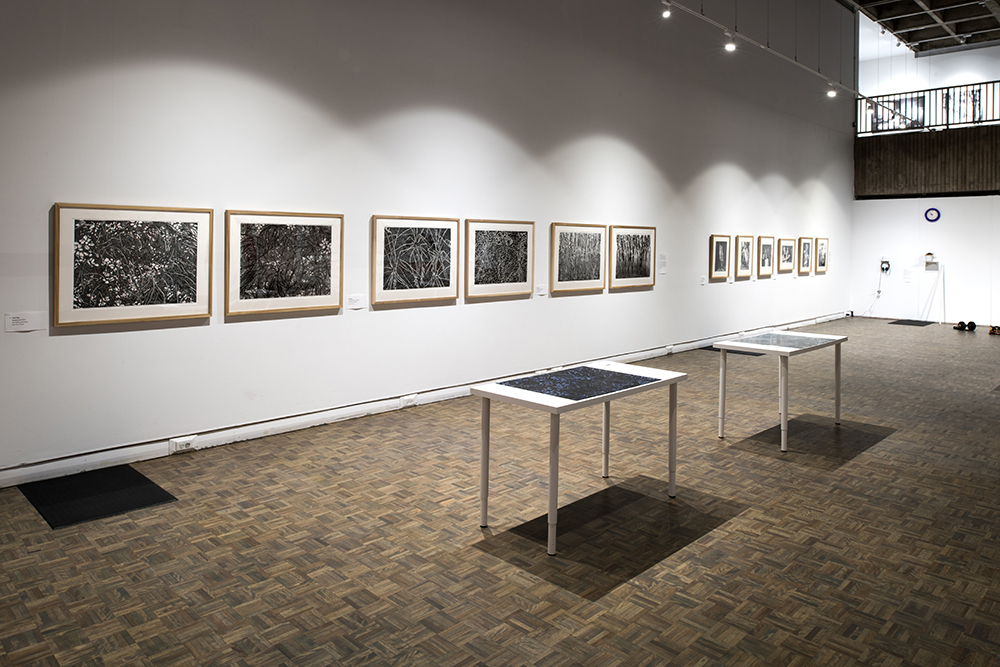I am in good health except for declining energy and arthritis starting in both hands. The approach of a time when I will no longer be able to handle acid or hand tools gives an urgency to work. I discard what doesn’t matter. Two years ago I began a series of images of undergrowth, thinking of death and regeneration along the lines of Walt Whitman’s What is Grass: “And now it seems to me the beautiful uncut hair of graves.”
These prints are large, for etching, a bit of bravado. I can still do this, although, of course, I don’t know for how long. More importantly, the size lets me work with the complex patterns and rhythms I enjoy. I worked each image in etching and linocut, rather than woodcut, which I gave up as my hands weakened. The etching plates are deeply etched so that the edges of forms hold the black ink, black to emphasize the graphic qualities in the image and because I no longer have the strength required to use a roller large enough to ink the plates in colour. However, I believe black and white suits this theme well.
The American-born artist Cecil Day lives in Port Maitland, Nova Scotia. After studies at Wellesley, she earned a BA in painting from Indiana University and an MFA from Washington University. Day has participated in numerous solo and group exhibitions since 1975, most recently at the Art Gallery of Nova Scotia, Halifax; The Rooms, St. John’s; and Sir Wilfred Grenfell College Art Gallery, Corner Brook. Day has taken part in multiple artist’s residencies in Newfoundland and France and her work is in public collections such as the Canada Council Art Bank, the Art Gallery of Nova Scotia and Memorial University of Newfoundland.
From the Artist
Audio Transcript
My name is Cecil Day and I live in southwest Nova Scotia. I am a printmaker.
My work in this exhibition consists of six prints. They are mounted in pairs and they depict wild plants at various seasons. Each pair is composed of one linocut and one etching with the same title. All of the prints are printed on white paper with black ink. Each print image measures 56 cm high by 76 cm wide.
These prints show an intimate landscape, the kind one perceives underfoot, like a carpet. I enjoy the patterns and repetitions in the similar forms and try to make textures that you would feel if you were to run your hand over a small patch of undergrowth.
The pair Fall Cinnamon Ferns shows four sprawling groups of white fern stems bent over a pattern of moss, fern leaves, and bunchberry dogwood, as if you were looking down on them.
The Winter Goldenrod pair depicts the black stalks and shrivelled leaves of winter goldenrod, crossing the plate like trees in a forest silhouetted against the light. White grasses twist around the stalks.
The Grasses linocut and etching show an all-over pattern of leaves and grasses, as if you might walk through them.
As I grow old I think of the earth as a repository for the dead: plants, birds, animals, humans; but also the place of their regeneration in the rich array of grasses and groundcovers. I remember the lines of Walt Whitman’s poem, What is Grass?: “And now it seems to me the beautiful uncut hair of graves.”
I have worked each pair of prints in linocut and etching. Linocut is a relief medium, meaning that the whites are cut out of the linoleum, and black ink is rolled on the upper surface with a brayer. I place the inked linoleum on the press bed, cover the linoleum with paper and run it through the press with light pressure. This transfers the image to the paper.
Etching is an intaglio medium meaning that the ink is held in the undersurface of the plate. The plate is covered with a ground that protects the plate from the acid. I draw through the ground and the acid bites a groove into the plate where I have drawn. After cleaning the plate I spread ink over all of it, and wipe off the surface of the plate, leaving the black ink in the grooves the acid has bitten. Then the plate is put on the press bed with damp paper over it and printed with great pressure.
The first image I made was Grasses. The linoleum block and the etching plate are included in this exhibition. When you touch the surface of the linoleum block you will feel the grooves and shapes I have cut out of the surface. Imagine them white and visually floating over the black background.
Touch the etching plate and you will be aware of the deeply etched forms. The black ink collects around each of these forms , making the pattern. Some of the grasses are also aqua tinted so they appear black and on top of the forms in the undergrowth.


(Fall Cinnamon Fern by Cecil Day – One etching, one lino-cut. Each 56 x 76 cm, 2017).




(Cecil Day, Winter Goldenrod, 2017
One etching, one lino-cut
Each: 56 x 76 cm)





